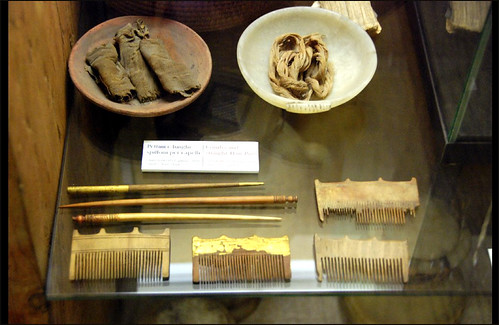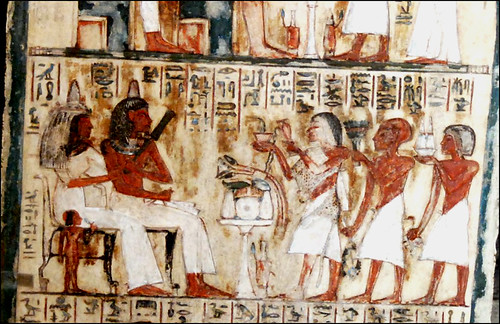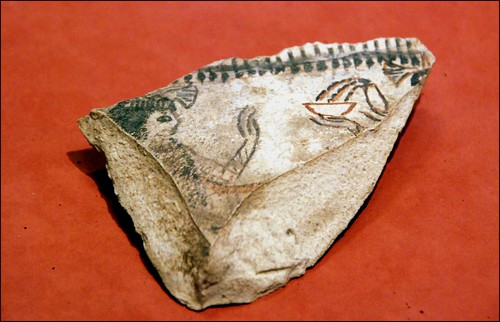| |
Galeria de Hans Ollermann
Deir el-Medina.
2008_0610_164358AA Egyptian Museum, Turin

Combs and straight hair pins.
From the Tomb of Kha (TT8), Deir el-Medina.
Dynasty XVIII, Reign of Amenhotep II, Tuthmose IV, & Amenhotep III.
(text Su, London)
Tomb of Kha and his wife Merit.
Kha was architect of the Pharaoh (Amenhotep II 18th Dynasty) and responsible for building projects not just in the reign of Amenhotep II, but also in the reign of 3 or 4 kings: Tuthmosis III, Amenhotep II, Tuthmosis IV and Amenhotep III
The intact tomb was discovered by E. Schiaparelli in 1906.
The access shaft to the funerary chamber was neither located in the chapel nor in the courtyard, but at a certain distance from both.
The collapse of a nearby Ramesside tomb had hidden it completely, thus preserving the burial intact through the course of 33 centuries.
A staircase led to a corridor and ante-chamber.
The funerary provisions were placed here because there was no room in the burial chamber itself at the time of the burial.
A bed, two baskets, two amphora's and a chair were also in this ante-chamber.
The entrance to the funeral chamber was blocked by a heavy wooden door that was closed on the in-side.
The chamber itself was rectangular with smooth plastered walls.
The great rectangular sarcophagi were inside, placed along the walls and covered with linen sheets.
A statue of Kha was on a chair, which stood in front of the sarcophagus of Merit.
It was garlanded with flowers.
Egyptian Museum, Turin.
Comentários
Lenka P  disse:
disse:
Oh Hans, I love the combs, I wanted to put these on the page but could not find the image. Fantastic! I myself use a wooden comb.... but I have only one and it has been glued together several times as it is quite impossible to find a new one.
Postado 20 meses atrás. ( permalink )
2008_0610_164935AA Egyptian Museum, Turin

Stela from Tomb of Kha (TT8), Deir el-Medina.
Detail.
Dynasty XVIII, Reign of Amenhotep II, Tuthmose IV, & Amenhotep III.
(text Su, London)
Tomb of Kha and his wife Merit.
Kha was architect of the Pharaoh (Amenhotep II 18th Dynasty) and responsible for building projects not just in the reign of Amenhotep II, but also in the reign of 3 or 4 kings: Tuthmosis III, Amenhotep II, Tuthmosis IV and Amenhotep III
The intact tomb was discovered by E. Schiaparelli in 1906.
The access shaft to the funerary chamber was neither located in the chapel nor in the courtyard, but at a certain distance from both.
The collapse of a nearby Ramesside tomb had hidden it completely, thus preserving the burial intact through the course of 33 centuries.
A staircase led to a corridor and ante-chamber.
The funerary provisions were placed here because there was no room in the burial chamber itself at the time of the burial.
A bed, two baskets, two amphora's and a chair were also in this ante-chamber.
The entrance to the funeral chamber was blocked by a heavy wooden door that was closed on the in-side.
The chamber itself was rectangular with smooth plastered walls.
The great rectangular sarcophagi were inside, placed along the walls and covered with linen sheets.
A statue of Kha was on a chair, which stood in front of the sarcophagus of Merit.
It was garlanded with flowers.
Egyptian Museum, Turin.

Swabti's of Kaemter.
Deir el-Medina.
Dynasty XVIII-XX (1550-1070 B.C.)
Egyptian Museum, Turin.
2008_1112_133022AA- Musée du Louvre, Paris.

Deux dessins d'une colonne.
19e-20e dynastie.
1295-1069 Av. J.-C.
Deir el-Medineh.
calcaire peint.
Ancient Egyptian ostraca in the Musée du Louvre, Paris.
2008_1112_131654AA- Musée du Louvre, Paris.
19e-20e dynastie.
1295-1069 Av. J.-C.
Village de Deir el-Medineh.
éclat de calcaire peint.
Ancient Egyptian ostraca in the Musée du Louvre, Paris.
2008_1112_130148AA- Musée du Louvre, Paris.

Chien chassant un bouquetin.
19e-20e dynastie.
1295-1069 Av. J.-C.
Village de Deir el-Medineh.
calcaire.
Ancient Egyptian ostraca in the Musée du Louvre, Paris.
viernes 19 de febrero de 2010
[AE-ES] RV: Sobre los bastones de Tutankhamón
De: Anjesenpaatón <ankhes_en_pa_aton@hotmail.com>
A: Lista de distribución de Amigos de la Egiptología
-----------------------------------------------------
Estimada Carmen Planchart:
Sigo con mucha atención las intervenciones en la lista de correo de A.E. No intervengo mucho, pero creo que tengo algún problema para escribir pues mis pocos mensajes me fueron devueltos.
Le adjunto una imagen en la que Nebjeperure Tutanjamón lleva un bastón y no está sentado.
Espero que les haya sido de ayuda en el tema de discusión.
Reciba un cordial saludo:
Ankhesenamón
Saludos A.E.'s:
A pesar de los muchos bastones de su tumba pocas por no decir ninguna son las representaciones del joven rey apoyado en un bastón. Las que está sentado dan la impresión que tiene un bastón a mano. Y la que hay de Berlin no tiene nombre y siempre se dice que pertenece a Smenkharre.
Os adjunto dicha fotografía...no es demasiado buena ...pero es la única que tengo.Cuando este yo mas calmada y haya pasado un poco la fiebre ADN que nos tiene poseídos os haré un explicito relato de lo que fui testimonio el domingo 14 de febrero en el Museo de Luxor... MªCarmen
Un cordial saludo desde: http://lagrutacerradadetaja.blogspot.com/ http://egyptaja.blogspot.com/ |
viernes 19 de febrero de 2010
Re: [AE-ES] Imagen
Muchas gracias, Mª del Carmen. Por lo menos, ya sé dónde buscar. Ya nos contarás, porque, lo que es a mí, me has dejado muy intrigada...
Un abrazo.
Mercedes González
Instituto de Estudios Científicos en Momias (IECIM)
------------
http://www.facebook.com/inbox/?tid=419036555075#/pages/Instituto-de-Estudios-Cientificos-en-Momias/140490073140?ref=ts
http://www.youtube.com/watch?v=XN-_kiI7aZ4&feature=related
http://www.youtube.com/watch?v=dwnNWvtggdA
viernes 19 de febrero de 2010
Re: [AE-ES] Imagen
Hola AEs
El tema de los numerosos bastones (130) hallados en la KV 62 siempre ha sido un poco intrigante dudándose de si su uso era ceremomial ó por algún problema físico, y como tampoco nos ha llegado "intacto" ningún otro ajuar funerario con el que comparar......
La llamada "Estela del Jardín" enviada por Carmen Planchart expuesta en el Museo de Berlín creo que no está plenamente identificada y dado su acusado estilo amarniense siempre se ha dudado entre 3 parejas reales: Akhenatón y Nefertiti, Smenkharé y Meritatón y, la más probable de Tutankhamón y Anjesenamón. La imagen enviada por Anjesenpatón es de uno de los cofres del Tesoro del rey.
Yo no recuerdo así ahora mismo otra imagen en la que porte un bastón de esta manera tan peculiar pues las dos estatuas del rey halladas en la tumba que portan bastón sí que tienen una pose ceremonial.
También se ha especulado sobre la escena en que Tutankhamón está cazando sentado (es una de las escenas de la Capillita Dorada) porque tiene el pie derecho como encogido...... pero que por otro lado ¿¿no tendría el Rey Niño un número elevado de cualquier objeto precisamente por ser rey ??
En fin que en absoluto éste es un tema cerrado ni siquiera con el último diganóstico de la enfermedad de Kohler que sí podría dificultar su caminar.
La llamada "Estela del Jardín" enviada por Carmen Planchart expuesta en el Museo de Berlín creo que no está plenamente identificada y dado su acusado estilo amarniense siempre se ha dudado entre 3 parejas reales: Akhenatón y Nefertiti, Smenkharé y Meritatón y, la más probable de Tutankhamón y Anjesenamón. La imagen enviada por Anjesenpatón es de uno de los cofres del Tesoro del rey.
Yo no recuerdo así ahora mismo otra imagen en la que porte un bastón de esta manera tan peculiar pues las dos estatuas del rey halladas en la tumba que portan bastón sí que tienen una pose ceremonial.
También se ha especulado sobre la escena en que Tutankhamón está cazando sentado (es una de las escenas de la Capillita Dorada) porque tiene el pie derecho como encogido...... pero que por otro lado ¿¿no tendría el Rey Niño un número elevado de cualquier objeto precisamente por ser rey ??
En fin que en absoluto éste es un tema cerrado ni siquiera con el último diganóstico de la enfermedad de Kohler que sí podría dificultar su caminar.
Espero no haberme extendido demasiado.
Un saludo
Herrera Ra
herrera_ra@hotmail.com
########################################## RSS Feed de Amigos de la Egiptología http://www.egiptologia.com/index.php?format=feed&TYPE=rss ##########################################
Todo sobre las Pirámides de Egipto http://www.egiptologia.com/todo-sobre-las-piramides.html
Recomendamos: Instituto de Estudios Arqueológicos Bíblicos http://www.ieab.net
--------------------------------------------------------------
Artículos sobre el Faraón:1. - [AE-ES] Test ADN momia Tutankhamon - ▼ feb 01 2010
2. - [AE-ES] Test ADN momia Tutankhamon - ▼ feb 14 2010
3. - Re: [AE-ES] Test ADN momia Tutankhamon - ▼ feb 16 2010
4. - [AE-ES] Noticia : Tutankamón murió de una enfermed... - ▼ feb 16 2010
5. - [AE-ES] Test ADN Tutanjamon. Copia del articulo - ▼ feb 17 2010
6. - [AMIGOSEGIPTOLOGIA] Reportaje : El paludismo remat... - ▼ feb 17 2010
7. - [AE-ES] RV: [AE] Ancestry and Pathology in King Tu... - ▼ feb 18 2010
8. - [AMIGOSEGIPTOLOGIA] Ancestry and Pathology in King... - ▼ feb 18 2010
9. - Categoría:Tutankamon - 19 Mar 2010
10. - Category:Treasure of Tutankhamun - 19 Mar 2010
11. - Category:14th century BC - 19 Mar 2010
12. - [AE-ES] RV: Sobre los bastones de Tutankhamón - 19 Mar 2010
13. - Tutankamón - Noticias - ABC Sevilla - 20 Mar 2010
14. - Tutankamón y el mundo de los faraones - 1100SC
15. - Tutankamon - 3255SC
16. - 01 - Tutankhamón El - Joven Faraón - Danizia
KV62 (esp.)
KV62 (ing.)
Category:KV62 (ing.)



